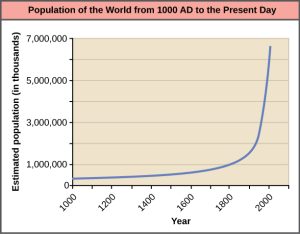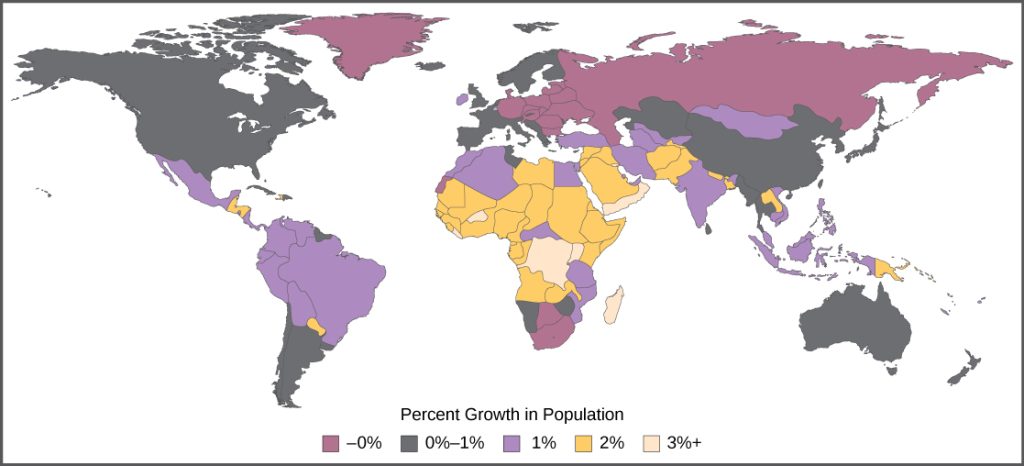4.4 The Human Population
Section Goals:
- Apply population growth models to the current global population.
- Understand how age structure of a population relates to predicted future population size.
- Consider population growth in different countries.
The Human Population
Concepts of animal population dynamics can be applied to human population growth. Humans are not unique in their ability to alter their environment. For example, beaver dams alter the stream environment where they are built. Humans, however, have the ability to alter their environment to increase its carrying capacity, sometimes to the detriment of other species. Earth’s human population and their use of resources are growing rapidly, to the extent that some worry about the ability of Earth’s environment to sustain its human population.

Long-term exponential growth carries with it the potential risks of famine, disease, and large-scale death, as well as social consequences of crowding such as increased crime. Please note that there is an uncomfortable and often ignored history of overconcern from members of “upper” society with the populations of people viewed as “less-than”, e.g., the people who believed in eugenics. Therefore, this topic is one where careful thought and additional reading are highly encouraged to ensure that structural inequalities are not perpetuated as we as a global society deal with the consequences of climate change.
Human technologies, most particularly our harnessing of the energy contained in fossil fuels, have caused unprecedented changes to Earth’s environment, altering ecosystems to the point where some may be in danger of collapse. There is overwhelming scientific consensus on this fact. Human-caused changes on a global scale including depletion of the ozone layer, desertification and topsoil loss, and global climate change. These challenges will be addressed more directly in the second half of this textbook (starting with Chapter 6). Because the way societies use resources is linked to individual choice, the fact that the population has accelerated since 1960 (Figure 2) is of note.
Human Population Growth

The fundamental cause of the acceleration of growth rate for humans in the past 200 years has been the reduced death rate due to changes in public health and sanitation. Clean drinking water and proper disposal sewage has drastically improved health in areas where it is implemented. Also, medical innovations such as the use of antibiotics and vaccines have decreased the ability of infectious disease to limit human population growth.
Age Structure, Population Growth, and Economic Development
The age structure of a population is an important factor in population dynamics. Age structure is the proportion of a population in different age classes. Models that incorporate age structure allow better prediction of population growth, plus the ability to associate this growth with the level of economic development in a region. Countries with rapid growth have a pyramidal shape in their age structure diagrams, showing a preponderance of younger individuals, many of whom are of reproductive age (Figure 3). This pattern is most often observed in underdeveloped countries where individuals do not live to old age because of less-than-optimal living conditions, and there is a high birth rate. Age structures of areas with slow growth, including developed countries such as the United States, still have a pyramidal structure, but with many fewer young and reproductive-aged individuals and a greater proportion of older individuals. Other developed countries, such as Italy, have zero population growth. The age structure of these populations is more conical, with an even greater percentage of middle-aged and older individuals.

Long-Term Consequences of Exponential Human Population Growth
“The battle to feed all of humanity is over. In the 1970s hundreds of millions of people will starve to death in spite of any crash programs embarked upon now. At this late date nothing can prevent a substantial increase in the world death rate.”
The actual growth rates in different countries are shown in Figure 4, with the highest rates tending to be in the less economically developed countries of Africa and Asia. Again, to reiterate the point at the beginning of this section: This topic has a history steeped in judgmental views (e.g., white supremacy). Please do not use this figure to judge or to perpetuate simplified perceptions of people.

Attribution
Human Population Growth by OpenStax is licensed under CC BY 4.0. Modified from the original by Joni Baumgarten.

